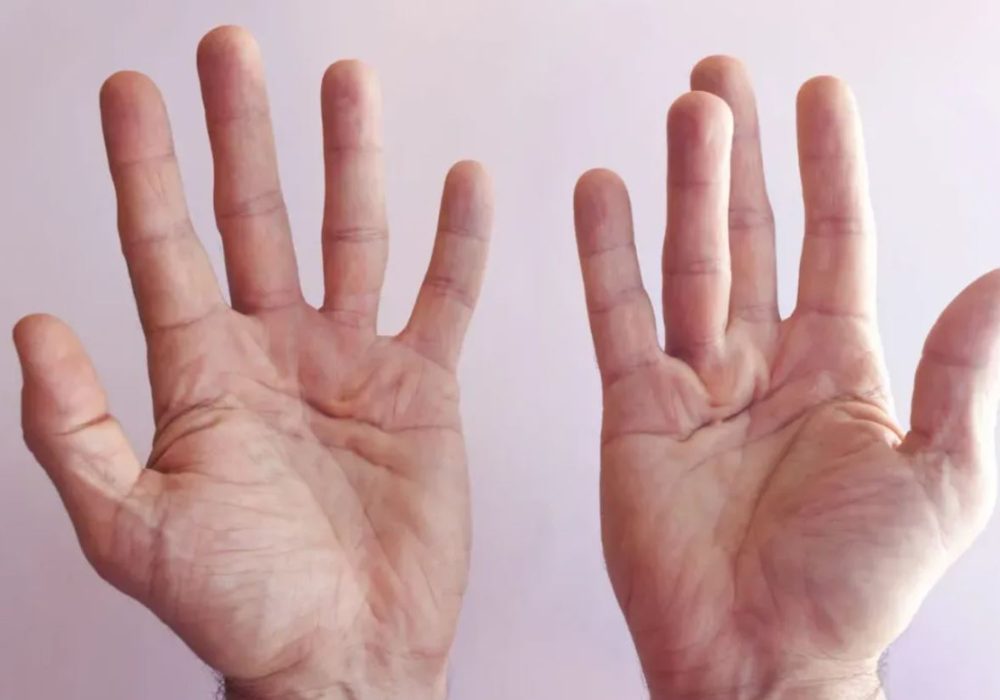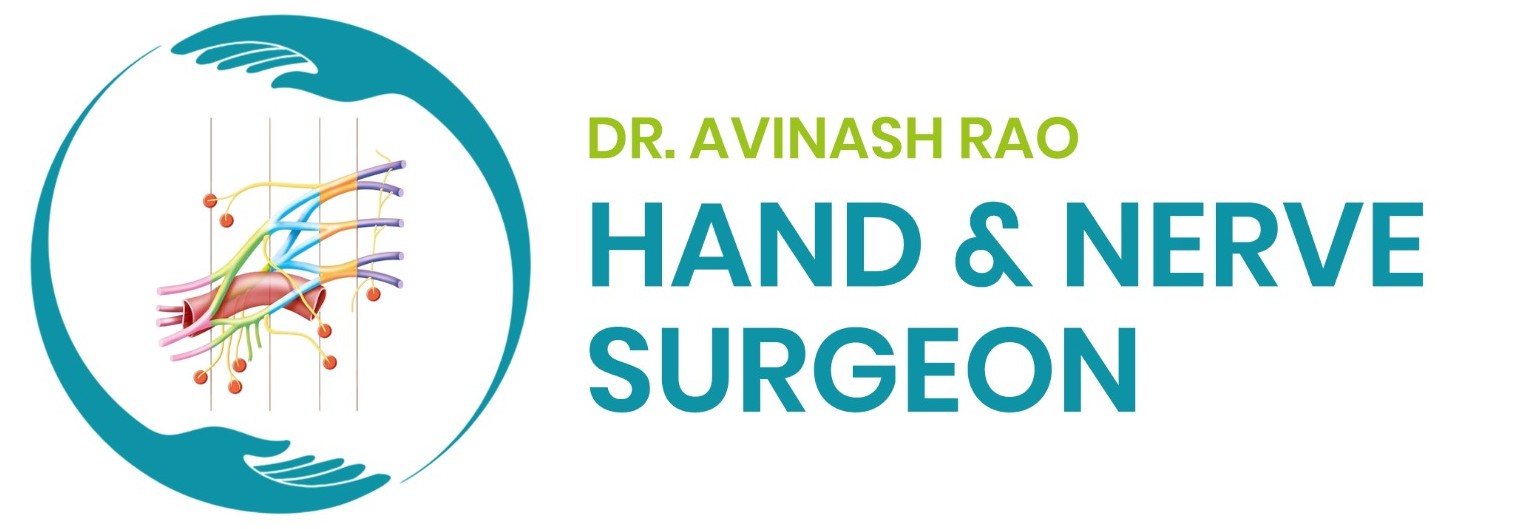
Dupuytren Contracture
Dupuytren contracture is a genetic disorder that makes the tissue under the skin of your palms and fingers thicken and tighten. There’s no cure, but symptoms take months or years to advance. There are lots of treatment options, including nonsurgical ways to relieve your symptoms.
Overview
What is Dupuytren contracture?
Dupuytren contracture (sometimes also called Dupuytren disease) is a genetic disorder that makes the tissue under the skin of your palms and fingers thicken and tighten. Small bumps (nodules) grow on your hand’s fascia — the rubber-band like tissue under your skin that supports your hand and fingers. Eventually, these growths can form thick cords under your skin and bend your fingers so much that you can’t straighten them.
Who does Dupuytren contracture affect?
Dupuytren contracture can affect anyone. Some people are more likely to develop it, including:
- Males.
- People of European descent.
- People with a family member who’s had it.
Dupuytren contracture and other conditions
- Diabetes.
- Epilepsy and other seizure disorders.
- Alcohol use disorder (formerly known as alcoholism).
- HIV and AIDS.
- Vascular disease.
How common is Dupuytren contracture?
Dupuytren contracture is rare. Around 5% of people experience it. People of European descent are much more likely to develop Dupuytren contracture than people from other ethnic backgrounds.
HAND PROBLEMS
- Fractures and Dislocations in Hand
- Metacarpal & Phalangeal fractures
- Ligamentous injuries of fingers & Thumb
- Dislocations of finger joints
- Swellings of Fingers & Hand
- Compartment Syndrome
- Mucous cyst
- Ganglion cyst / Retinacular Cyst
- GCT of Tendon sheath
- Enchondroma (Benign Bone Tumor)
- Squamous cell carcinoma
- Dupuytrens Contracture
- Post Traumatic Contracture
- Post Burn Contractures of fingers
- Volkmann Ischemic Contracture
- Stiff Fingers & CRPS
- Stiff joints of fingers and hand
- Osteoarthritis of Hand
- Finger joint arthritis
- Thumb Basal joint arthritis
- Acute Infections of Hand
- Finger Pulp Infection (Felon)
- Nail Fold Infection (Paronychia)
- Finger Infection (Flexor Tenosynovitis)
- Palm Infection (Deep Spaces of Hand infection)
- Joint Infections in Hand & Wrist (Septic Arthritis)
- Human & Animal bite injuries to hand
- Diabetic Hand Infections
- Bacterial / Fungal / Atypical Hand infections in immunocompromised patients
- Subungual Hematoma
- Nail bed injury
- Nail Deformities
- Glomus tumor
Make Your Appointment
How does Dupuytren contracture affect my body?
Dupuytren contracture might never affect your body in a way you notice. If you have mild symptoms, you may never even know you have it. Even if you do have symptoms, it usually takes a long time (months or years) for them to progress (get worse). In later stages, it might be hard — or impossible — to straighten your affected fingers.
Dupuytren contracture can affect any of your fingers — including your thumb. It’s most common in people’s fingers in the following order:
- Ring (fourth finger).
- Pinkie (fifth finger).
- Index (second finger).
- Thumb (first finger).
Can Dupuytren contracture affect other parts of the body?
Dupuytren contracture can only affect your hands. It can’t develop in other parts of your body. Even though it’s related to other connective tissue disorders that can develop in other places in your body, you’ll never develop Dupuytren contracture anywhere other than your hands.
Some people with Dupuytren contracture are more likely to experience similar conditions like Ledderhose disease and Peyronie’s disease.
Symptoms and Causes
What are the symptoms of Dupuytren contracture?
Dupuytren contracture can take months or even years to develop, so you might not notice any symptoms at first. Symptoms of Dupuytren contracture usually develop in the following order:
- Nodules: Small bumps under the skin on your palm are the first sign of Dupuytren contracture. They’re usually at the base of your fingers where they meet your palm. You might be able to feel or seem them. Some people never get symptoms beyond nodules, and some people’s nodules go away on their own. The nodules might make the skin around them look dimpled or puckered.
- Cords: Over time, the nodules may thicken into long cords of tissue on your fascia. The cords can pull on your fingers and make it feel like they’re constantly being pulled in, toward you palm.
- Contracture: The most advanced symptom is what gives Dupuytren contracture its name. Eventually, the cords can grow so tight and thick it might be impossible for you to extend or straighten your affected fingers away from your palm.
Unlike other conditions, there aren’t usually triggers that aggravate Dupuytren contracture’s symptoms. If you have it, your symptoms may slowly get worse over time as nodules turn into cords and then might cause contracture. Some people never progress through all stages of symptoms.
Additional symptoms
In addition to the issues with your fingers, you might have the following symptoms in your affected hand:
- Inflammation or swelling.
- Tenderness.
- Pain or burning.
- Itching.
These symptoms are rare. Only around one-quarter of people with Dupuytren contracture will experience them. Talk to your provider if you have Dupuytren contracture and you experience these symptoms — they can sometimes be a sign of other issues that can affect your skin or fascia.
What causes Dupuytren contracture?
Experts aren’t sure what causes Dupuytren contracture. It’s considered a genetic disorder because it’s been proven that you’re much more likely to develop Dupuytren contracture if one of your family members has had it.
Dupuytren contracture is the most common inherited disorder that affects connective tissue.
Diagnosis and Tests
How is Dupuytren contracture diagnosed?
A healthcare provider will diagnose Dupuytren contracture with a physical exam of your hand. They’ll look at your hand and fingers, feel for nodules and cords under your skin and measure how severe your contracture may be.
Which tests will be done to diagnose Dupuytren contracture?
There aren’t any special tests used to diagnose Dupuytren contracture. Your provider may order blood tests or X-rays to check for other conditions that can affect your hands.
Management and Treatment
How is Dupuytren contracture treated?
Your provider will treat your Dupuytren contracture in several stages, depending on how severe your symptoms are.
Because Dupuytren contracture develops so slowly, it might take months or years for you to need the next level of treatment. Your symptoms might also be resolved with early treatments, and you’ll never need additional options. You might need to repeat some steps of treatment if your early symptoms recur (come back).
Conservative treatment
Conservative treatments for Dupuytren contracture include:
- Physical therapy or stretching exercises.
- Bracing or splinting to stretch your fingers to their usual range of motion (how far you can move them).
- Ultrasonic (painless sound waves) or heat treatments to increase your fascia’s flexibility.
- Corticosteroid injections to shrink nodules and cords.
Radiation Therapy
Your provider may refer you to a radiation specialist to help treat Dupuytren contracture or prevent your symptoms from progressing. Radiation therapy is a painless procedure that involves using X-rays or other beams aimed at the nodules or cords to soften them.
Radiation therapy is used to treat some types of cancer. But Dupuytren contracture isn’t cancer, and having it doesn’t mean you have (or will develop) cancer.
Needle aponeurotomy
If your symptoms haven’t improved after a few months of conservative treatments, your provider might recommend needle aponeurotomy. This procedure is sometimes called a percutaneous needle fasciotomy. Needle aponeurotomy is an outpatient procedure your provider can perform in their office.
Your provider will numb your hand with a local anesthetic, then poke holes in your hand’s fascia with a needle to release tension and straighten your fingers.
Collagenase injections
Your provider might inject collagenase into the nodules or cords to treat Dupuytren contracture. Collagenase is an enzyme that helps loosen and break down the growths on your fascia. First, your provider will inject collagenase directly into the nodules or cords. Then you’ll come back the next day and they’ll numb your hand and stretch your affected fingers back out to their original range of motion.
Dupuytren contracture surgery
If your contracture is so severe that it interferes with your quality of life, you might need surgery. Dupuytren contracture surgery is an outpatient procedure, which means you can go home the same day.
Your surgeon will perform what’s called a fasciectomy. They’ll numb your hand with a local anesthetic and then remove some or all of your affected fascia. How much they need to remove depends on how much your fascia has thickened, and how severe the contracture is. You might need physical or occupational therapy after your surgery to help your joints return to their usual strength.
Is there a cure for Dupuytren contracture?
There’s no cure for Dupuytren contracture. However, almost all cases are manageable with treatment.
Because there isn’t a cure, around 1 in 5 people develop Dupuytren contracture again, even after surgery to remove their affected fascia. If this happens, you’ll need more treatment in the future.
How can I manage the symptoms of Dupuytren contracture?
Follow the instructions your provider gives you to manage your Dupuytren contracture symptoms. If you have stretches to perform or need to wear a splint or brace, make sure to do so as often as your provider instructs.
How soon after treatment will I feel better?
Follow the instructions your provider gives you to manage your Dupuytren contracture symptoms. If you have stretches to perform or need to wear a splint or brace, make sure to do so as often as your provider instructs.
How long it takes to feel better depends on how your Dupuytren contracture was treated:
- Conservative treatments sometimes take months to improve your symptoms.
- Needle aponeurotomy should improve your contracture right away.
- Surgery should relieve your symptoms, but you won’t notice the full improvement for up to two months after you recover. After surgery, you’ll need to let your hand heal. You’ll also need physical or occupational therapy for at least a few months to help your hand regain its strength and range of motion.
Talk to your provider before resuming any of your regular activities while you’re recovering.
Dupuytren contracture treatment complications
Complications of Dupuytren contracture treatment can include:
- Pain.
- Nerve damage.
- Infection.
- Scarring.
- Damage to your blood vessels.
- Wound healing problems.
How long does Dupuytren contracture last?
Because it develops over months or years, it’s easier to think about Dupuytren contracture like a progression of symptoms you do or don’t have yet, rather than a disease that has a timeframe.
After treatment, you might re-develop Dupuytren contracture in the future. But, even if you do, your provider can treat it in the same ways they did the first time.
Will I need to miss work or school with Dupuytren contracture?
You shouldn’t have to miss work or school if you’re receiving conservative treatment for Dupuytren contracture.
If you need a needle aponeurotomy or surgery, you might need to take some time away from your job or schoolwork if you can’t do them with your hand in a brace or splint. Talk to your provider about when you can resume your normal activities after treatment.
How can I reduce my risk of developing Dupuytren contracture?
There’s nothing you can do to prevent Dupuytren contracture. In the same way that there’s no cure, it develops without warning. Talk to your provider if someone in your family has been diagnosed with Dupuytren contracture.
